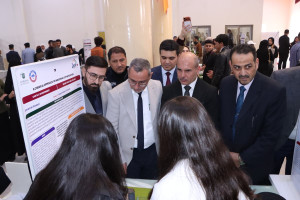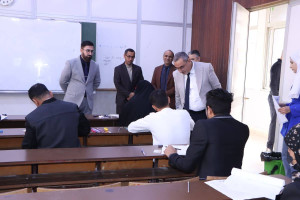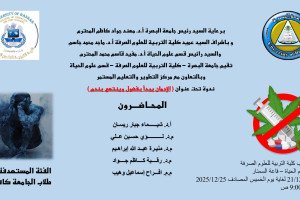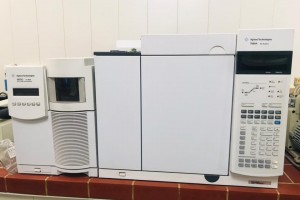
The College of Education for Pure Sciences at the University of Basrah discussed a master's thesis on (an ecological and taxonomic study of blue-green algae and measuring the concentrations of microcystin toxins in the Shatt al-Arab, southern Iraq)
The thesis presented by the researcher (Hanan Dawood Kedimi) included
Due to the lack of environmental studies related to diagnosing and measuring the concentrations of algal toxins, especially hepatoxins (microcystins) in Iraqi water bodies, environmental factors, and algae producers, the study decided to investigate microcystins in the waters of the Shatt al-Arab and in the biomass of algae in the selected study sites for a period of one year. Complete from October 2020 to September 2021, as the study included the diagnosis of blue-green algae roaming in the waters of the Shatt al-Arab in three locations along the river, namely al-Siba, al-Ashar and al-Hartha, as 57 species belonging to 23 common genus were diagnosed, and the quantitative diagnosis of microcystins was also made. The study included measuring some physical and chemical environmental factors on a monthly basis in the three study sites such as air and water temperatures, pH, salinity, dissolved oxygen and the biological requirement for oxygen, and during this study the concentrations of some nutrients were measured As important as active nitrates and active phosphates, it was found in this study that Swallowing Those environmental factors measured during the study period had an effect on the concentrations of hepatoxins (MCs) in the algal biomass in Shatt Al-Arab waters.
The study has been concluded
. The concentrations of hepatoxins within the algal biomass are higher than in the waters of the Shatt al-Arab, and the concentrations of these toxins in the river water have exceeded the limit allowed by the World Health Organization, which is 1 microgram / liter. Accordingly, this water body is unfit for human use or for the rest of the living organisms.
. Dominance of toxic species of algae, including Microcystis aeroginosa and Oscillatoria limosa, in the study sites.
Message recommended
. The importance of carrying out diagnostic and quantitative studies for all types of toxins that may be produced from blue-green algae or spindle algae in the Shatt al-Arab,
. The study recommends paying attention to the molecular diagnosis of microcystin toxins produced from blue-green algae, and the possibility of early and rapid diagnosis in an attempt to limit their spread.
. Directing residents and citizens and educating them on the need to pay attention to and maintain the cleanliness of the Shatt al-Arab environment, especially the recreational places along the river, by placing banners and jackets urging them to do so, and preventing the flow of household and restaurant waste across the Khandaq and al-Ashar rivers and the rest of the other branches to prevent the blooming of blue-green algae and other harmful algae.








